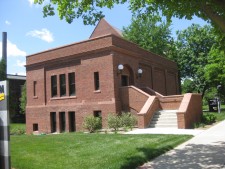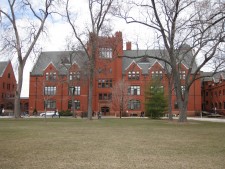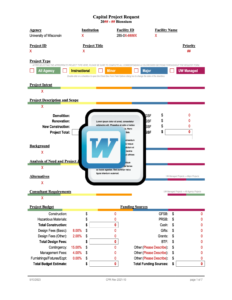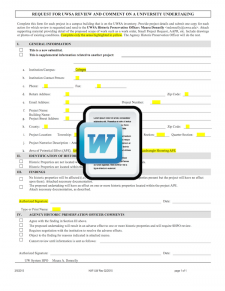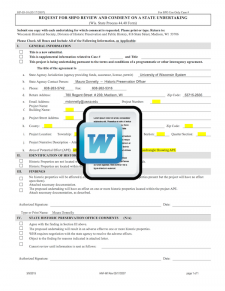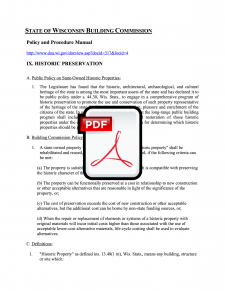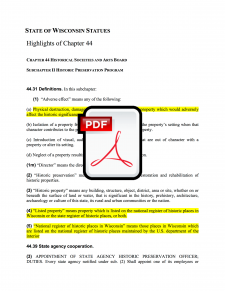Background
Wisconsin state statutes, Chapter 44, subchapter II sets requirements for the preservation of historic assets with specific requirements that apply to state agencies, including assessing actions to determine whether they will affect historic properties. The University of Wisconsin System Historic Preservation Officer (HPO) is responsible for the coordination of all functions of that state agency related to historic properties and acts as the liaison between that state agency and the state historical society. The HPO may further delegate these responsibilities to institution staff when appropriate. Actions that are deemed to affect historic properties are required to be submitted to the State Historic Preservation Officer (SHPO), who is staff of the Wisconsin Historic Society, for review
The State Building Commission also has policies governing historic preservation. In general (Section IX) they require agencies to take means to preserve and maintain historic buildings.
- Before any project affecting a historic property is submitted to the building commission for approval, a determination must be made, in cooperation with the Division of Facilities Development, on whether the requested action will affect the historic property.
- There are requirements for historic properties that are declared surplus, and for which the UW system wishes to, transfer, sell, or demolish.
Historic properties contribute to the physical context of campuses, providing scale, detail, and richness. Often historic buildings are the most beloved places on campus. With appropriate maintenance and effective renovation, historic properties can continue to serve as valuable functional and aesthetic resources to UW System institutions. The Wisconsin Historical Society maintains a database that lists each building on the state and national inventory.
Adverse Effect and Effect
Wis. Stat. §44.31 defines adverse effect as meaning any of the following…
- Physical destruction, damage or alteration of any part of a property which would adversely affect the historic significance of that property.
- Isolation of a property from or alteration of the character of the property’s setting when that character contributes to the property’s qualification as a listed property.
- Introduction of visual, audible or atmospheric elements that are out of character with a property or alter its setting.
- Neglect of a property resulting in its deterioration or destruction.
The state law does not explicitly define the term effect, but the Code of Federal Regulations, Title 36, which governs historic properties, provides the following definition in 36 CFR §800.16 (i): Effect means alteration to the characteristics of a historic property qualifying it for inclusion in or eligibility for the National Register. Based on these definitions, examples of actions that would not have an effect or an adverse effect include:
- Not a historic property;
- Ground disturbance will not go near an archeological site (in an area already archeologically surveyed);
- Ground disturbance will occur in areas of prior ground disturbance such that no archeological sites will be affected. For example, any architectural sites that may have been there have already been destroyed at that location;
- No permanent changes to the appearance of the project area will persist after completion of the project: no buildings, other structures, or landscapes that may be present within the project area will be permanently impacted;
- Historic property (subject of the project) won’t be impacted if:
- Building repairs are made with limited in-kind replacement materials that match original specifications when existing materials are “beyond feasible repair” (with SHPO concurrence), resulting in no net change to the property.
- Project does not result in wholesale replacement of historic materials.
- Project does not change any of the visual qualities of the original design or introduce new elements that did not historically exist.
- Work does not involve additions to the building, window replacements, repointing, stone or brick repair or replacement, removal of original walls, or partitions, changes in roofline, massing, scale, or removal and replacement of decorative elements.
Since there is a continuing need to implement maintenance projects on historic buildings, and many of these projects have limited scopes of work, detailed review of every action by the UW System HPO and the SHPO is not practical. Therefore, a tiered review assessment has been established to provide guidance to institutions. There are three tiers of actions. Tier 1 actions will require the most extensive level of review and documentation; Tier 3 the least. Institutions anticipating actions on a historic property should consult with the HPO to determine the appropriate review level.
Listing Categories
There are various categories of listed properties, each of which require different levels of preservation care. The highest category includes properties that are designated a National Historic Landmark or listed on the U.S. Department of the Interior National Register of Historic Places or the State Register of Historic Places, or both. Buildings within this category may have both exterior and interior features that contribute to the historic nature of the building. Actions affecting either interior or exterior features need to be assessed for potential effects, and any adverse effects will need to be mitigated.
Some properties are listed as contributing properties within a historic district. In this category the exterior facade is the primary contributor to the historic listing, however, interior components may exist that also contribute to the historic property designation. Actions in this category are primarily evaluated based on effects on exterior facades; any adverse effects will need to be mitigated.
Properties that are listed on the historic inventory and not yet listed on any state or national register may have features that would make them eligible for listing at a future date. However, since properties can be placed on the inventory without any evaluation process, UW System has further clarified with the State Historical Society which properties on the inventory are eligible for listing and will require a review of actions. The Historic Preservation Officer maintains a list of those eligible properties that will need to be assessed for potential effects or potential adverse effects.
Review Process
Capital projects that involve properties listed on state or national registers will require greater care than typical projects to assure that adverse affects are avoided or appropriately mitigated. Depending on information available, such projects may require that a Facility Condition Assessment, a Historic Structures Report, and/or a Preservation Plan be prepared to understand the impact of the proposed project on the building.
Projects that affect the land around a listed building also need to be assessed for potential effects or adverse effects. Modifying the landscaping, sidewalks, or street right-of-way could potentially have an effect or adverse effect on the property.
Prior to presenting any project affecting a historic property to the Building Commission for approval, state agencies must conform with Wis. Stats § 44.40, relating to consideration of impact on historic properties and negotiations to ameliorate adverse effects on historic properties.
Sometimes, the determination on whether or not an action affects a historic property may be based on subtle distinctions. In general, actions that are readily reversible are not considered to have an effect. For example, mounting a sign on a building is readily reversible, since the sign could be removed. However, even reversible actions could have adverse effects. For example, replacing historic windows with windows of a modern appearance would likely be considered to have an adverse effect, even if the windows could be replaced at a future date with appropriate historic windows.
Tier 1 and Tier 2 actions are those that could have an effect or an adverse effect and will require completion of a UW Historic Assessment Form documenting the action. The submittal shall include any supporting information that will outline the proposed scope of work in the needed detail, such as a campus work order, Small Project Request or an [Capital Project Request] (CPR). That form and supporting documentation will be sent to the HPO for review, who will determine whether completion of a WI Historic Assessment Form and submittal to the Wisconsin Historical Society will be required. If the HPO determines that the action is a Tier 1, the HPO will complete a [WI Historic Assessment Form] and submit that form to the Wisconsin Historical Society for review. If the HPO determines that the action is a Tier 2, the HPO will sign the [UW Historic Assessment Form] and return a copy to the institution. The HPO will maintain records of Tier 1 and Tier 2 actions. Tier 3 actions are those that will not have an effect or an adverse effect. Tier 3 actions will not require the completion of any form or additional review. However, the institution should consult with the HPO before making that determination.
Capital Project Request (CPR)
Description: Universal project request document for all capital project types (All Agency, Instructional Space, Minor, Major, and UW Managed).
Purpose: Describes project intent, scope, justification, budget estimate, schedule, and design consultant requirements for maintenance and repair, remodeling, renovation, and/or new construction valued at $300,000 or more. Posted to UWSA or WisBUILD websites to advertise for professional design consultants. Used as source documentation and basis for Agency Request document advanced to the Board of Regents (BOR) and State Building Commission (SBC) to seek construction authority.
Audience: Board of Regents, UW System Administration, UW Institutions, Division of Facilities Development, Architectural/Engineering/Planning Consultants.
Revision ID: Rev 2023-05
UW Historic Preservation Assessment Form (University of Wisconsin System)
Description: Request for UW System Historical Preservation Officer review and comment on proposed work for UW property.
Purpose: Describes address and location of historic properties, proposed project scope description, and indicates historic preservation findings of both the submitter and the historical preservation officer reviewing the proposal. Additional attachments (site plans, project drawings and details, photographs, etc.) typically accompany this form to fully articulate and illustrate the proposed work.
Audience: UW System Administration.
Revision ID: Rev 2015-02
WI Historic Preservation Assessment Form (WI Historical Society 44.40 Form)
Description: Request for State Historical Preservation Officer review and comment on proposed work for state property.
Purpose: Describes address and location of historic properties, proposed project scope description, and indicates historic preservation findings of both the submitter and the historical preservation officer reviewing the proposal. Additional attachments (site plans, project drawings and details, photographs, etc.) typically accompany this form to fully articulate and illustrate the proposed work.
Audience: State of Wisconsin Historical Society, UW System Administration.
Revision ID: Rev 2015-02
State Building Commission (SBC) Policy and Procedure Manual Excerpt
Description: Section IX of the WI State Building Commission Policy and Procedures highlights for historical preservation activities and projects.
Purpose: Outlines public policy on state-owned historic properties, state building commission policy, procedure for compliance with policy, closing and maintenance of unoccupied state buildings, and demolition or transfer of surplus state buildings.
Audience: UW System Administration, UW Institutions, Division of Facilities Development, Architectural/Engineering/Planning Consultants.
Revision ID: Rev 08/2011
State of Wisconsin Statutes, Chapter 44 Excerpt
Description: WI Statutes Chapter 44 “Historical Societies and Arts Board, Subchapter II: Historic Preservation Program” highlights for historical preservation activities and projects.
Purpose: Defines specific historical preservation terminology; outlines state agency cooperation, decisions, and negotiation; and the protection and use of state agency property.
Audience: UW System Administration, UW Institutions, Division of Facilities Development, Architectural/Engineering/Planning Consultants.
Revision ID: Rev 03/2015

